Kyoto, Otra Vez
Webbo (Paul Webb, also called Beautiful Paul) was leaving Japan and he wanted to go to Kyoto, so being the good friend that I was, I offered to go with him. Harry (Paul Harrington, or Tall Paul), also a bend-over-backwards kind of guy, secured a couple days off and came along. We rode the Shink down to Tokyo and then took a night bus from Tokyo stations.



Tokyo is always busy.

The bus was luxurious, as was expected. In fact it was called the Kyoto Dream bus.
 Paul is a sleep-emailer. Very strange.
Paul is a sleep-emailer. Very strange.I got a total of 2.3 hours of sleep. It was that amazing. I don't think I had any dreams, unless it was about disembarking from such cramped quarters.
 Kyoto station was still there; I know some of you were beginning to doubt.
Kyoto station was still there; I know some of you were beginning to doubt.
We got to Kyoto at about half 5 in the morning. We got some breakfast munchies at a konbenii (convenience store) and grubbed down in a temple courtyard. We timed our trip pretty well so the cherry blossoms were beginning to show.
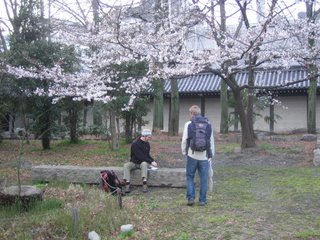

 After breakfast we went into the temple and as fortune would have it, there was a buddhist ceremony about to begin. We sat down and listened as the monks chanted in Japanese and then sang a few songs. Webbo and I actually slept through most of it, but it was a sweet experience, nonetheless.
After breakfast we went into the temple and as fortune would have it, there was a buddhist ceremony about to begin. We sat down and listened as the monks chanted in Japanese and then sang a few songs. Webbo and I actually slept through most of it, but it was a sweet experience, nonetheless.Afterwards, we headed up to the Imperial palace and peroused the gardens for a bit. We wanted to go to another part of the Imperial palaces, but you must apply for permission in person. So we set up a tour of Katsura Rikyu Imperial villa for Wednesday.


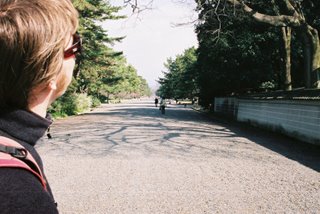
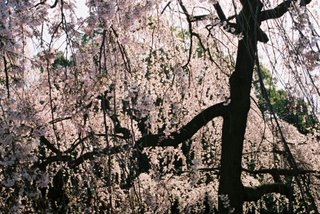
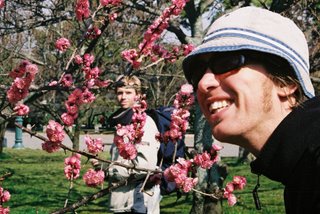

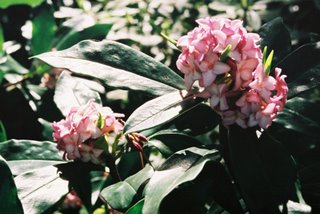
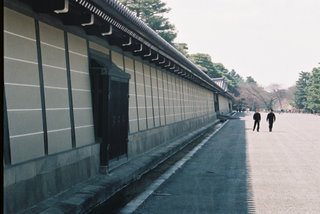 After checking into our hotel, we hired some bikes and started cycling toward Kurama Dera, about 6 miles out of Kyoto. While taking a slight detour from the main road, we happened upon this family at their little cherry blossom party (heretofor refered to as hanami). They were all lined up for a photographer, so I snuck up behind him to take a shot of my own. He was finished shooting, and the family caught sight of me and told him to move so I could take my picture. They were really nice; they tried to talk to me, but as I only know three sentences in Japanese, the conversation was shortlived.
After checking into our hotel, we hired some bikes and started cycling toward Kurama Dera, about 6 miles out of Kyoto. While taking a slight detour from the main road, we happened upon this family at their little cherry blossom party (heretofor refered to as hanami). They were all lined up for a photographer, so I snuck up behind him to take a shot of my own. He was finished shooting, and the family caught sight of me and told him to move so I could take my picture. They were really nice; they tried to talk to me, but as I only know three sentences in Japanese, the conversation was shortlived.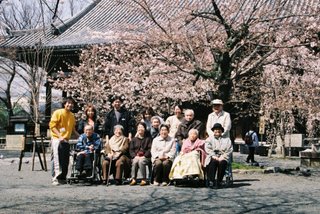 We cycled for another hour or so, but had to stop when Harry got a puncture in his tire. We took a lunchbreak and boarded the train to Kurama-dera.
We cycled for another hour or so, but had to stop when Harry got a puncture in his tire. We took a lunchbreak and boarded the train to Kurama-dera.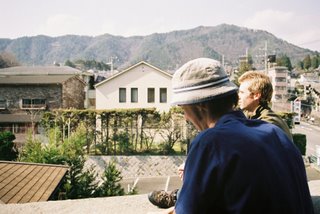 At the entrance to Kurama-dera.
At the entrance to Kurama-dera.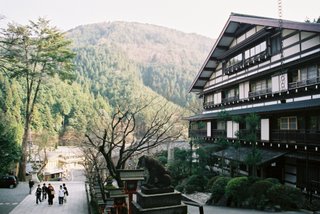

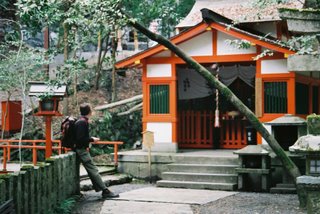
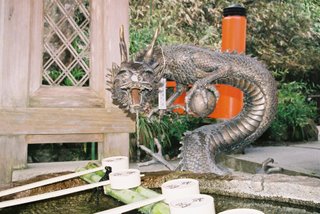
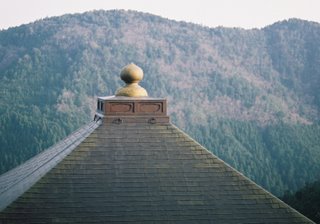
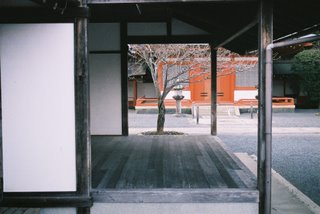
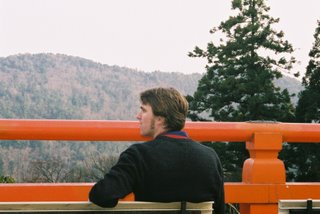

 The temple complex winds from the bottom of a valley to the top of the overshadowing mountain. It took us the better part of an hour to hike to the top. We got to the top about dusk, so on the way down, it was continually getting darker. I had had the forsight to bring along my tripod, which afforded us many exctiting low-light photo opportunities.
The temple complex winds from the bottom of a valley to the top of the overshadowing mountain. It took us the better part of an hour to hike to the top. We got to the top about dusk, so on the way down, it was continually getting darker. I had had the forsight to bring along my tripod, which afforded us many exctiting low-light photo opportunities.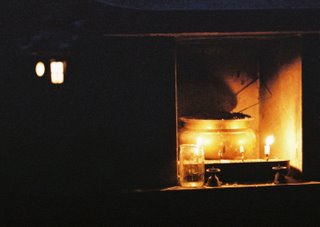
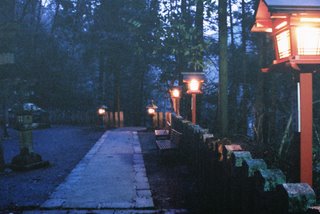
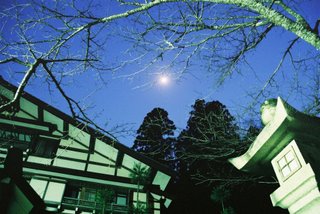
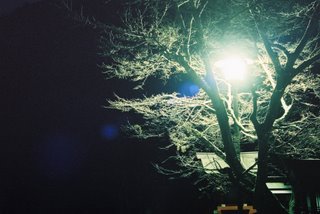 We left Kurama-dera, and cycled back to town, stopped for dinner, and then headed down to a nice area, where we thought we might see some quaint backstreets and such. What you see below is a nice little stream overcast with cherry blossoms.
We left Kurama-dera, and cycled back to town, stopped for dinner, and then headed down to a nice area, where we thought we might see some quaint backstreets and such. What you see below is a nice little stream overcast with cherry blossoms.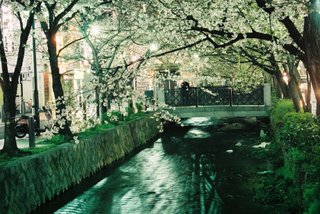
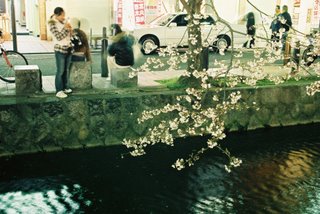
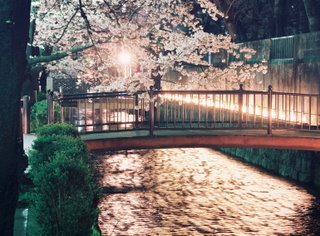
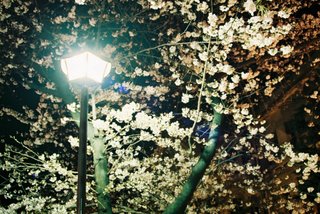
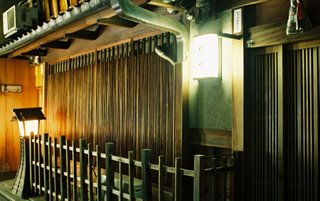 Anyway, we had to crash, as it was about 1am, so we cycled back to our hotel, and got a short sleep before we hit the town for day two.
Anyway, we had to crash, as it was about 1am, so we cycled back to our hotel, and got a short sleep before we hit the town for day two.Harry had seen a flyer for an exhibit concerning traditional food from Kyoto, so he headed to the musuem early the next day. Webbo and I slept for a couple hours more, and headed out to Nijo-jo, the old Imperial castle.
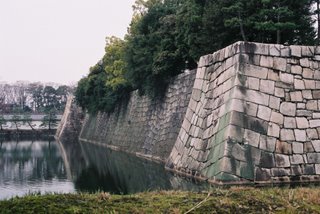
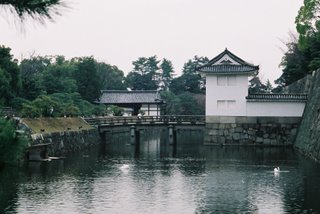 It was pretty sweet, although we missed the real extent of the cherry blossoms by two or three days. Probably the coolest part of the castle was the old palace within, of which I neglected to take any pictures. The floors were made especially to make walking silently impossible. Called "mockingbird floors", they were specially designed to alert the Shogun of any intuders. Of course I tried to walk without making a sound. But it was only possible for a maximum of two or three steps. The sound was really unique, too; it wasn't like a squeaky floor, but somewhere between that and a hand-carved flute.
It was pretty sweet, although we missed the real extent of the cherry blossoms by two or three days. Probably the coolest part of the castle was the old palace within, of which I neglected to take any pictures. The floors were made especially to make walking silently impossible. Called "mockingbird floors", they were specially designed to alert the Shogun of any intuders. Of course I tried to walk without making a sound. But it was only possible for a maximum of two or three steps. The sound was really unique, too; it wasn't like a squeaky floor, but somewhere between that and a hand-carved flute.We met up with Harry for some coffee, and then headed out toward Kiyomizu-dera. Ben and I had gone up to the enterance to the temple in the fall, but thought that it looked pretty lame from the outside, so we didn't go in. However, I had since learned that we had missed the best part. As can be seen from the pictures, it's pretty sweet.
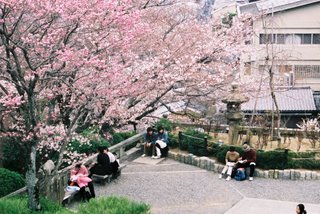
 Here's some girls in kimono. They had just purchased their omikuji (fortune) from the temple and from their excited squeals they had all gotten good luck. However, it couldn't have been that good, as I didn't suddenly learn how to speak Japanese and go over to flirt with them.
Here's some girls in kimono. They had just purchased their omikuji (fortune) from the temple and from their excited squeals they had all gotten good luck. However, it couldn't have been that good, as I didn't suddenly learn how to speak Japanese and go over to flirt with them.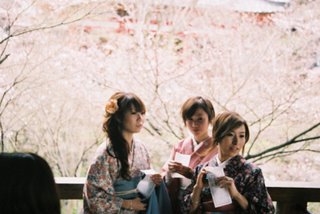
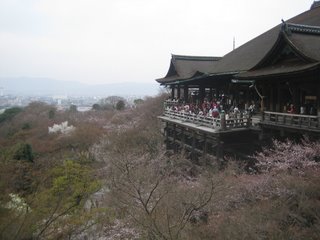
 Some more girls in kimono. The girl on the left is my future wife, by the way.
Some more girls in kimono. The girl on the left is my future wife, by the way.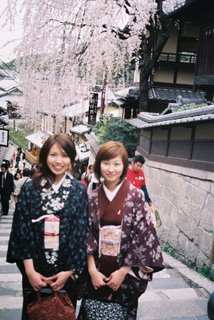
Day Three, we ditched the bikes, and took the bus. We were going to Katsura Rikyu and we had an hour to kill, so we walked to a temple just about a mile away from the train station. As it turns out, the five-story pagoda is very famous. Who would've guessed?
 In typical little-kid fashion, this girl was utterly facinated by standing up to her ancles in a puddle with her waterproof booties on.
In typical little-kid fashion, this girl was utterly facinated by standing up to her ancles in a puddle with her waterproof booties on.

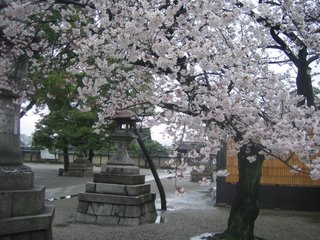

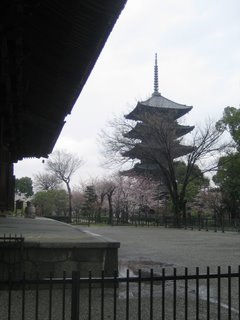 This is outside of Katusura Rikyu. we were on the far west side of Kyoto, but if felt as though were were in a totally different valley. The weather had been a bit drizzly, but it had cleared up, and I was reminded of Guatemala. Maybe it was that cool, fresh post-rain feeling, coupled with the surrounding grey outlines of the mountains, but whatever it was, it was sweet.
This is outside of Katusura Rikyu. we were on the far west side of Kyoto, but if felt as though were were in a totally different valley. The weather had been a bit drizzly, but it had cleared up, and I was reminded of Guatemala. Maybe it was that cool, fresh post-rain feeling, coupled with the surrounding grey outlines of the mountains, but whatever it was, it was sweet. The villa was built beside the Katsura river, a little ways out of Kyoto (at the time) by the brother of one of the emperor's. It consisted of a villa, several tea houses, and a small shrine, all built around a spectacularly scenic garden. We were given a guided tour throughout the garden. I mentioned earlier about the requesting of permission. It was really strange. You had to have the special permission papers, and your name had to be on the list, and they wouldn't let you wander around by yourself or take pictures wherever you liked. (The English audio guides we recieved informed us that because the moss in the garden is "invaluable" flash photography is prohibited except in certain areas; apparently the moss doesn't grow.) It was like you were a privileged (but not honored) guest.
The villa was built beside the Katsura river, a little ways out of Kyoto (at the time) by the brother of one of the emperor's. It consisted of a villa, several tea houses, and a small shrine, all built around a spectacularly scenic garden. We were given a guided tour throughout the garden. I mentioned earlier about the requesting of permission. It was really strange. You had to have the special permission papers, and your name had to be on the list, and they wouldn't let you wander around by yourself or take pictures wherever you liked. (The English audio guides we recieved informed us that because the moss in the garden is "invaluable" flash photography is prohibited except in certain areas; apparently the moss doesn't grow.) It was like you were a privileged (but not honored) guest.

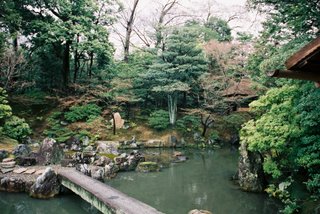 This is one of the tea houses. When I say tea houses, they would perform a formal ceremony of drinking tea. I don't really know much about it, but it was one of the things that Samurai and Maiko would practice to perfection. So while you're walking through the garden, you stop to have some tea in this amazing little house and look out over the pond. The luxury of the house is so striking. It's so delicate: paper windows, sliding doors, and tatami floors. Everything about it urges the tennant to take great care. And also it's so open. The doors and windows are huge, to allow a flow of light and air, and even were they to be closed, you wouldn't feel much protection from the elements, bringing one even closer to the magnificent garden around it. Sorry if I sound poetic, it was just really amazing.
This is one of the tea houses. When I say tea houses, they would perform a formal ceremony of drinking tea. I don't really know much about it, but it was one of the things that Samurai and Maiko would practice to perfection. So while you're walking through the garden, you stop to have some tea in this amazing little house and look out over the pond. The luxury of the house is so striking. It's so delicate: paper windows, sliding doors, and tatami floors. Everything about it urges the tennant to take great care. And also it's so open. The doors and windows are huge, to allow a flow of light and air, and even were they to be closed, you wouldn't feel much protection from the elements, bringing one even closer to the magnificent garden around it. Sorry if I sound poetic, it was just really amazing.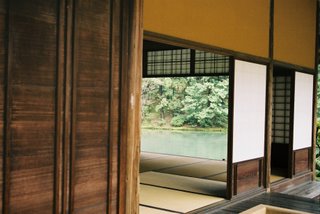

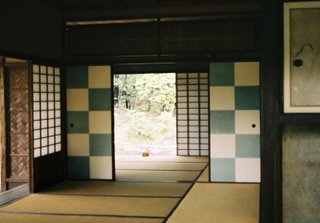 The shrine.
The shrine.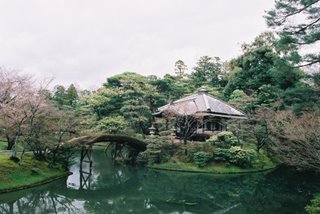 Another of the tea houses.
Another of the tea houses. This is the villa itself. On the flat grass patch in the foreground, they would practice Japanese archery (kyudo) and kendo.
This is the villa itself. On the flat grass patch in the foreground, they would practice Japanese archery (kyudo) and kendo.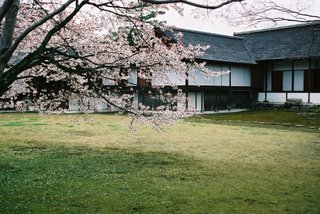
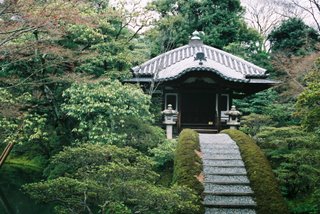
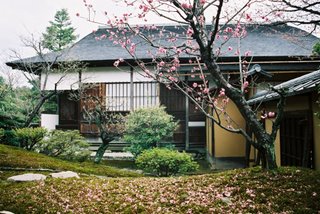 This was the last of the tea houses, it was build in a sort of L-shape with two large windows at right angles to each other.
This was the last of the tea houses, it was build in a sort of L-shape with two large windows at right angles to each other.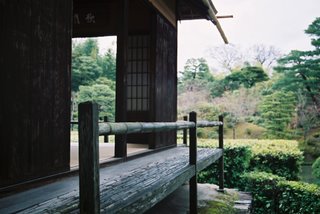 If you sit looking straight ahead, you see this small knoll with its shrubs and flowers.
If you sit looking straight ahead, you see this small knoll with its shrubs and flowers.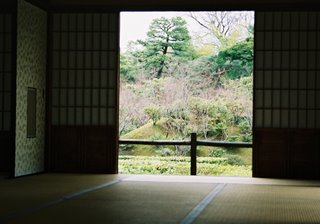 If you then look to your right, you see this picture: the pond with a vague outline of a shore.
If you then look to your right, you see this picture: the pond with a vague outline of a shore. 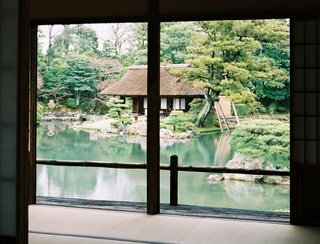 It was built so that the two windows would provide glimpses of two totally different landscapes, the first eluding to land and the second to the sea, as though you were seeing two pictures of two different worlds.
It was built so that the two windows would provide glimpses of two totally different landscapes, the first eluding to land and the second to the sea, as though you were seeing two pictures of two different worlds.The pine tree on the right was planted so that one could not view the garden all at one time, thus "saving some enjoyment" for the visitor as he traversed the path around the pond. Those crazy Japanese.
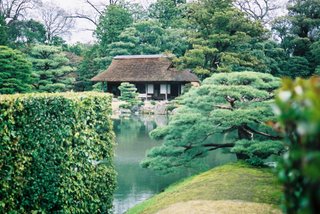 That dude was stationed there so that anyone thinking of spoiling his enjoyment would immediately get scared and decide to walk the path around the pond.
That dude was stationed there so that anyone thinking of spoiling his enjoyment would immediately get scared and decide to walk the path around the pond.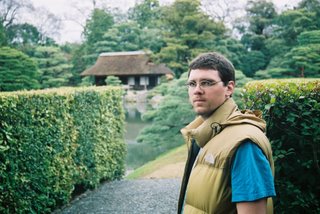
After the villa, we headed to the other side of town for a little peak at Fushimi-inari Taisha, famous for it's hallways of torii that wind through the forests outside of Kyoto. For the layperson who couldn't figure it out, a torii is a gateway usually at the entrance to a temple or shrine. I believe they are meant to have some sort of spirtual effect, but I know not what. I do know that they use the red paint to scare away demons.


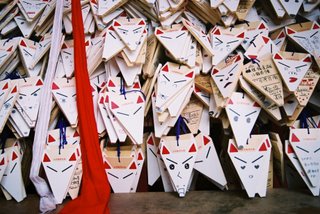


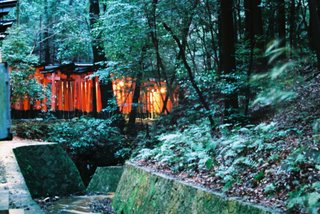
After the torii, we had to board the nightbus for Koriyama. Our time in Kyoto had unfortunately come to an end.
